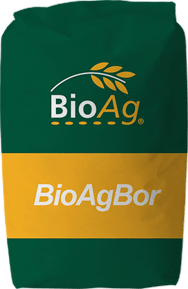Trace elements
BioAg offers a full range of trace elements for blending with our range of solid fertilisers, as well as a proprietary range of specialist products with unique characteristics and benefits.
Trace elements are essential nutrients and when in deficit or excess, will likely influence crop yields or stock production.
Trace elements are always present in the soil, but a crop or plants access to them may be negatively impacted by such factors as soil pH, soil composition, nutrient imbalance, low soil carbon levels or poor soil microbial activity.
Whatever the cause, a shortfall or excess in trace element supply to crops results in economic loss.
Identifying issues related to the supply of trace elements to crops is a key component of optimising yields and stock returns, where deficiencies in pastures and fodder become a dietary deficiency for stock, potentially impacting stock growth, health, and reproduction.
More information
Supply of trace elements can be performed through a number of methods. Typically, issues will be addressed through the incorporation of trace elements in a blend with solid fertilisers. However, in circumstances where either; soils are antagonistic to one or more trace elements, the crop stage is in high demand for a trace element, or an immediate issue has been identified in a leaf test, tissue test or crop inspection caused by an unidentified soil issue or abiotic or seasonal conditions, foliar applications are worth considering.
Supply of trace elements is rarely as simple as applying the product. Consideration needs to be given to the form of the trace element applied and to the chelation, or binding of the trace element with an organic ion, to minimise losses and improve plant uptake.
In soils this is performed by microbes present in the soil and if soils are balanced this should occur naturally. Chelation is a slow process, and soil antagonists may bind trace elements, or trace elements may leach out of the root zone in high rainfall events with porous soils. Ensuring an adequate supply of trace elements may also require soil parameters to be addressed, such as pH or CEC.
When using foliar applications, BioAg offers a range of biostimulants that act as natural chelators of trace element salts, aiding in their retention and uptake.
In addition, a range of chelated trace elements are available on the market. Your BioAg representative is available to review your soils and or tissue test results and discuss the options available and the pros and cons of each.
 Benefits
Benefits
- Important in optimising crop yields, minimising the risk of crop disease and avoiding negative impacts in reproductive phases
- Important in optimising stock production and maintaining stock health
- Correction of soil parameters will impact the availability of trace elements
- Foliar applications provide an immediate remedy to nutrient deficiencies identified through leaf tests, tissue tests or observation
- Compatible with BioAg’s range of foliar biostimulants and, when combined, enhance crop performance.
Product Range

BioAgBor
Trace Element
A sustained-release form of boron suited to a range of enterprises such as horticulture, vegetables, pastures and field crops.

BioAg CuZin
Liquid Fertiliser
A liquid fertiliser solution of zinc and copper. Ideal for use in a range of farming enterprises, especially when addressing and preventing zinc and copper deficiencies.

BioAg Zinc
Liquid Fertiliser
A liquid fertiliser solution of zinc. Ideal for use in a range of farming enterprises, especially when addressing and preventing zinc deficiencies.

Committed to organics
With a core range of natural fertilisers and biostimulants, BioAg can offer an extensive range of products certified by Australian Organics, suitable for use in organic systems.
